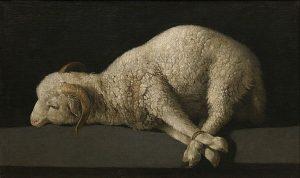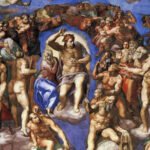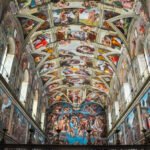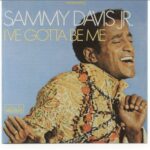
A Review of 75 Masterpieces Every Christian Should Know. By Terry Glaspey.
Baker, 2015.
I seem to have the sort of personality or temperament where I tend to see more evil, pain, suffering and ugliness in the world than I do goodness, pleasure, joy and beauty. Both make sense in the Christian worldview: the latter because we are made in God’s image and under his common grace, and the former because of sin and the Fall.
So when I recently bought this volume and read through it, the good and the beautiful came much more to the fore. In the world of art and aesthetics, it is neat to know how much and how many of the great things of art we have appreciated and loved for centuries are the result of Christians and biblical Christianity.
 The subtitle of this book is “The Fascinating Stories behind Great Works of Art, Literature, Music, and Film”. Faith was the inspiration for these amazing works of art. The artists were either Christians or greatly impacted by the Christian faith.
The subtitle of this book is “The Fascinating Stories behind Great Works of Art, Literature, Music, and Film”. Faith was the inspiration for these amazing works of art. The artists were either Christians or greatly impacted by the Christian faith.
Each entry gets around four or five pages, including glossy colour photos. It is a terrific book, and Glaspey is certainly fully adept at giving us informed commentary on a great range of artists and works of art. Here we find works of poetry, music, architecture, sculpture, literature, paintings, drawings, and other forms of art carefully and insightfully explained, as well as detailed information about the artist in question and his historical and cultural setting.
One of course could quibble about what works were included and left out – that would be inevitable with so many great artistic works to choose from. He informs us that these “creative expressions of faith … range across time, genres, and nationalities. This is most emphatically not a list of the absolute best or greatest works, nor does it imply any ranking system.”
The appearance of the works are arranged chronologically, so we have early on things like the paintings in the Roman catacombs (c. 300), Gregorian chants (c. 580), Chartres Cathedral (1134), the stained glass windows of Sainte-Chapelle (1248), and Dante’s The Divine Comedy (c. 1320).
And then we have things from very recent times such as music by Larry Norman, Only Visiting this Planet (1972), Bruce Cockburn, Dancing in the Dragon’s Jaws (1979) and Bob Dylan’s Christian albums (early 80s), as well as novels such as Walker Percy’s The Second Coming (1980) and Frederick Buechner’s Godric (1981).
In between are so many famous and beautiful works, such as Michelangelo’s The Ceiling of the Sistine Chapel (1508-12), Martin Luther’s A Mighty Fortress is Our God (c. 1529), Rembrandt’s The Return of the Prodigal (c. 1669), John Bunyan’s The Pilgrim’s Progress (1678), Handel’s Messiah (1741), Pride and Prejudice by Jane Austin (1813), The Brothers Karamazov by Dostoyevsky (1879), and Gaudi’s La Sagrada Familia Cathedral in Barcelona (begun in 1882).
More recent pieces include: Emily Dickenson’s The Complete Poems (1890), Chesterton’s The Innocence of Father Brown (1911), The Man Born to Be King by Dorothy Sayers (1943), It’s a Wonderful Life by Frank Capra (1946), The Chronicles of Narnia by Lewis (1950-1956) and The Lord of the Rings by Tolkien (1954-1955).


So there is something here for everyone, covering a wide range of tastes, favourites, genres and historical periods. Consider just a few of these great works of art in a bit more detail. The great European cathedrals, of which Chartres is a sterling example, were more than just magnificent and beautiful pieces of architecture.
They were quite significant for the common man, with the tall, soaring structures lifting both eyes and hearts to heaven. Indeed, in an age of illiteracy for so many, the biblical stories came alive in the stained glass windows and sculptures and statues. The biblical stories and themes are visually on display, bridging the present world with the world to come.
Millions of believers have sung with gusto Amazing Grace but may not know its background. John Newton was a former slave ship captain who had a wonderful conversion and helped William Wilberforce in the great cause of the abolition of slavery.
Newton often wrote a hymn to accompany his sermons, and for his New Year’s Day 1773 sermon based on 1 Chronicles 17:16-17 he also offered this hymn. The hymn was especially used widely by the revivalists during the Second Great Awakening (1780-1840).
Jane Austin’s great novels, including Pride and Prejudice, were the result of a devout Anglican life. She attended church regularly and enjoyed reading sermons. Her novels are full of truths about Christian living, including the fleeting fame of charm and social approval, and the need for “constancy,” the need for enduring and deeper virtues and social traits.
The Black American painter Henry Ossawa Tanner (1859-1937) was raised during the Civil War, and his mother had been a slave, later rescued by the Underground Railroad. His dad became a minister, then Bishop, in the African Methodist Episcopal Church.
While still young he saw an artist at work in a park, and from then on knew what his life’s work would be. He studied art in France, and his works are characterised by the use of light as a means of bringing divine meaning into ordinary situations. His classic 1898 work, The Annunciation offers this in full display.
In it Mary is depicted in very ordinary surroundings, but the divine meets with the human as an angel informs her about how she would become the mother of the Messiah. We are reminded, says Glaspey, that God “communicates to perfectly ordinary human beings in perfectly ordinary circumstances. And the holiness that infuses the picture is less in the flood of golden light and more in the look on Mary’s face, captured in the moment when fear is beginning to give way to contemplation and acceptance.”
Finally, consider Dorothy Sayers, who many non-believers know quite well for her brilliant crime fiction novels, featuring Lord Peter Wimsey. But she wrote many theological works, as well as religious dramas, The Man Born to Be King being one of her most memorable works.
In these religious plays she sought to “present the Christian faith in all its scandalous confrontation with our tidy modern pieties. She saw her primary task, though, not as trying to figure out how to illustrate the Christian doctrines but as telling a good story – entertaining and coherent – and letting the theology emerge.”
This is a terrific book, and one can of course pick it up and read wherever one likes. One can pick an artist or a novel or a piece of music or a work of architecture. It reminds us that our God is a God of superlative beauty, and is wonderfully creative.
Thus even in a fallen world his creatures can reflect some of this beauty and creativity. We are, as Tolkien called us, sub-creators. This book reminds us again of all these truths. The works of art found here inspire us, move us, and should bring us to sing praises to God and glorify his name. As such, it is a very helpful volume indeed.
(Available in Australia at Koorong Books.)
[1169 words]




















Happy Father’s Day, Bill Muehlenberg.
Hope you had a grand day!!!
Many thanks Phil.
I recently visited The Metropolitan Museum of Art in New York. I am not an artist in any discipline, but I do appreciate the art of others.
The Met has many sections where the majority of the works on display are predominantly Christian.
Included in the dozen or so Rembrandt portraits, there is evidence of his Christian Faith.
Many portraits were commissioned by wealthy patrons as evidence of their faith.
Much of European art for many centuries is contained within an artistic expression of Christian Faith by the artists, the subjects, the patrons or the churches that commissioned them.
I am disappointed in the meagre amount of time I allocated to my visit.
For anyone with a real artistic eye and an eye for history, The Met is incredible in its rich vaults of art across many mediums.
Thanks Bill. I’ve ordered this book – one for myself and one for a Christmas gift. Sounds great.
As many nations abandon Christianity, the significance of these works will be harder to understand. Not so long ago I studied Gerard Manley Hopkins for the HSC. His poetry is deeply devout. I can’t imagine them being studied for the HSC anymore.
I just have to add Gerard Manley Hopkins’ poem in – the last time it is mentioned as an HSC text was 16 years ago…while my whole class studied it and all his other poems as a standard text not all that long ago.
God’s Grandeur
Gerard Manley Hopkins, 1844 – 1889
The world is charged with the grandeur of God.
It will flame out, like shining from shook foil;
It gathers to a greatness, like the ooze of oil
Crushed. Why do men then now not reck his rod?
Generations have trod, have trod, have trod;
And all is seared with trade; bleared, smeared with toil;
And wears man’s smudge and shares man’s smell: the soil
Is bare now, nor can foot feel, being shod.
And for all this, nature is never spent;
There lives the dearest freshness deep down things;
And though the last lights off the black West went
Oh, morning, at the brown brink eastward, springs–
Because the Holy Ghost over the bent
World broods with warm breast and with ah! bright wings.